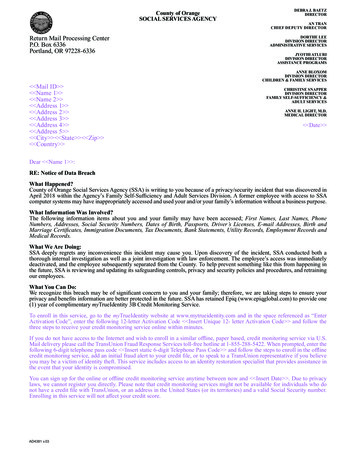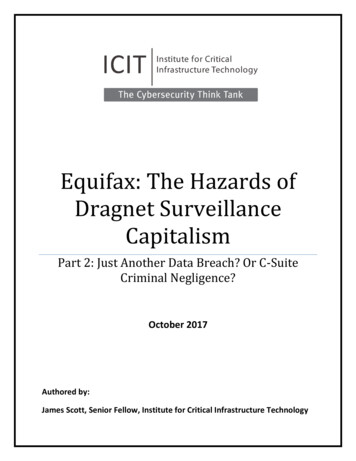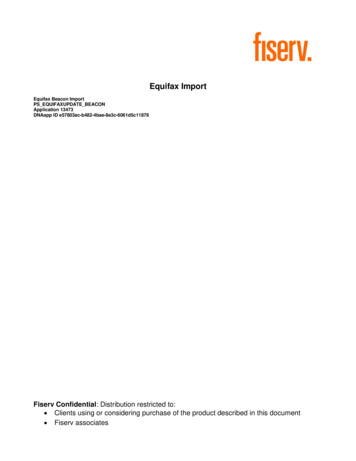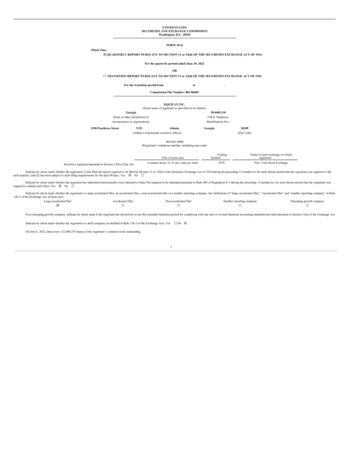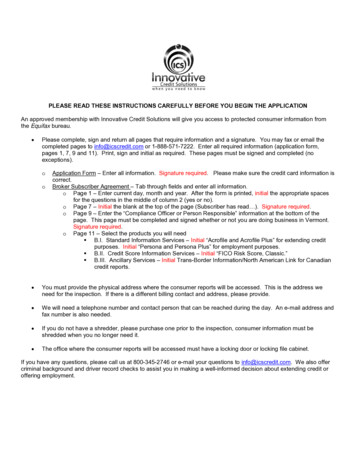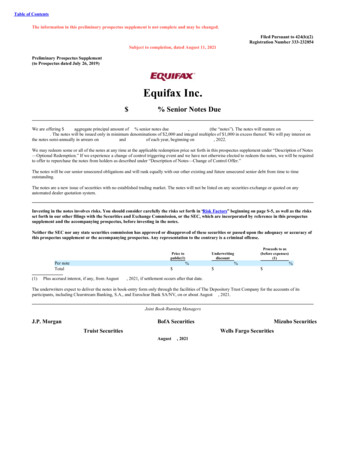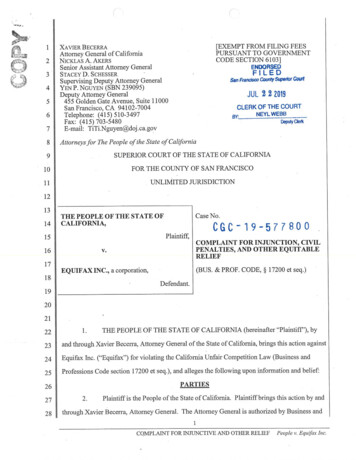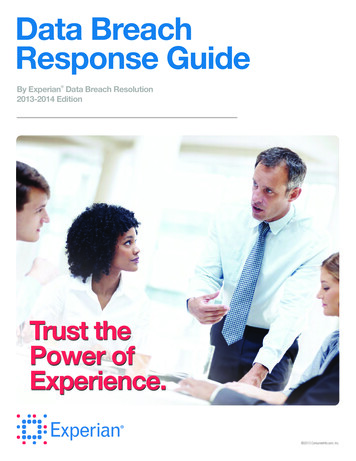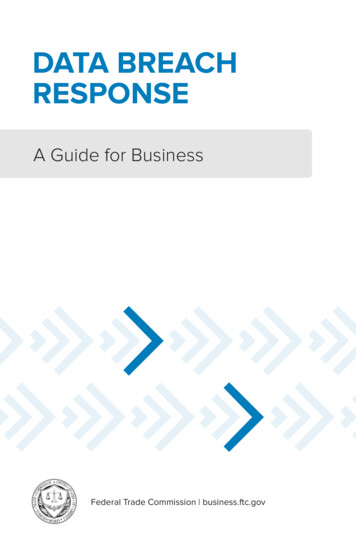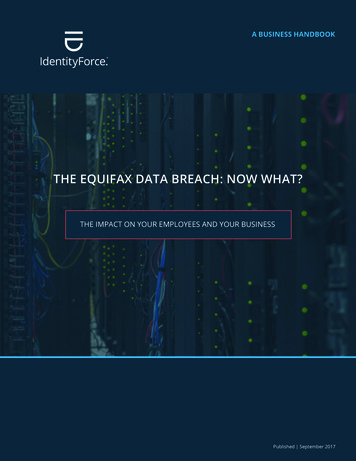
Transcription
A BUSINESS HANDBOOKTHE EQUIFAX DATA BREACH: NOW WHAT?THE IMPACT ON YOUR EMPLOYEES AND YOUR BUSINESSPublished September 2017
DATA BREACH IMPACTApproximately 143 million Americans, or nearly half of the U.S. population, hadtheir personal data exposed in the Equifax cyber incident between mid-Maythrough July 2017, according to the company.1 What made this data breach somuch more devastating than garden-variety hacks was that the crown jewels ofpersonal identity — Social Security Numbers (SSNs), names, and dates of birth— were stolen. This information is likely to remain unchanged forever for mostvictims, which extends the risk for consumers virtually in perpetuity. As a result,there will undoubtedly be significant, potentially negative ripple effects acrossyour company’s customers and employees for years to come.MAJOR DATA BREACHES BY THE NUMBERSAlthough the Equifax data breach was not the largest theft of personalinformation, it may be the most potentially damaging. Here are some quick factsabout other major data breaches: In May 2014, Yahoo reported the theft of 500 million Yahoo user accounts,including names, email addresses, telephone numbers, dates of birth, and,in some cases, encrypted and unencrypted security questions and answers,according to a 2016 USA Today report.2 Myspace reported a breach of 360 million user accounts and LinkedIn exposed100 million users to potential identity theft risk in May 2016. They join a longdateline of damaging hacking attacks over the past decade, from AOLBreached Data: The Crown Jewels (October 2007) to JP Morgan Chase (October 2013) and from Target(November 2013) to Anthem (February 2015).3of Personal IdentityInformation that was likelycompromised in the Equifax databreach includes: Social Security Numbers (SSNs) Driver’s license numbers Full names Dates of births Addresses Credit card numbers for 209,000customers1. “Equifax Releases Details on Cybersecurity Event, Announces Personnel Changes,” Equifax.com press release,September 15, 2017.2. “500 million Yahoo accounts breached,” USA Today, September 22, 2016.3. “Yahoo may be the biggest data breach,” USA Today, September 22, 2016.THE EQUIFAX DATA BREACH: NOW WHAT? 2017 IdentityForce, Inc. All other trademarks or trade names are properties of their respective owners. All rights reserved.2
WHAT BUSINESS LEADERS NEED TO KNOWA major cause for concern with the Equifax event was the 40-day delay in makingthe public aware of the intrusion, per media reports. (At the time of this writing,there are some reports that a second major Equifax breach occurred in March2017.) The gap between detecting the theft and Equifax’s management teamannouncing it to the public on September 7th was due to several factors. Thecompany most likely needed to patch vulnerabilities in its security infrastructure,determine the scope of how much data was stolen, and inform law enforcementofficials who no doubt wanted time to try to identify the hackers before thecompany released information. In the interval, the criminals likely could cover orat least obscure their digital tracks — making detection and capture that muchmore difficult.Equifax’s crisis response plan also invited controversy. It included creating awebsite so that those potentially exposed to the breach could confirm whethertheir personal information was compromised. They also offered consumers a freecredit freeze and time-limited free membership to TrustedID, a suite of Equifax’sown security products.Beside the fact that consumers may be leery of using Equifax, there are alsoseveral major structural problems with Equifax’s response. First, a credit freezeis just a tool. It’s not a solution designed to protect employees or individualconsumers from identity theft. In addition, the credit freeze that Equifax is offeringonly applies to its credit bureau — it does not address user activity at Experianand TransUnion, the other two major U.S. credit monitoring services.Second, the Equifax package is significantly limited, as it is only focused on credit.It does not directly address or protect consumers from the massive fallout ofhaving a compromised personal identity. According to IdentityForce’s CEO, StevenBearak, “Credit fraud only makes up 28% of identity theft risk. If all the consumerdoes is freeze their credit, they haven’t addressed the other 72% of identity theftactivities that could affect them, from health insurance fraud to pilfering of awardspoints — scams for which there is an active, mature, and lucrative black market,especially within the Dark Web.”“Credit fraud only makes up 28%of identity theft risk. If all theconsumer does is freeze theircredit, they haven’t addressed theother 72% of identity theft activitiesthat could affect them, from healthinsurance fraud to pilfering ofawards points — scams for whichthere is an active, mature, andlucrative black market, especiallywithin the Dark Web.”What should not be lost in discussions about the scope of the Equifaxdata breach and the company’s response is the immutable fact thatPersonally Identifiable Information (PII) of 44% of the US populationhas been jeopardized. In the months and years to come, thiscould have a seriously detrimental impact on the economy and onbusinesses that rely on employees and customers trusting that theirPII will be safeguarded.— Steven Bearak, CEO, IdentityForceTHE EQUIFAX DATA BREACH: NOW WHAT? 2017 IdentityForce, Inc. All other trademarks or trade names are properties of their respective owners. All rights reserved.3
DISRUPTION TO YOUR EMPLOYEES:A SERIOUS PRESSURE COOKERFor an American workforce that is already anxious about protecting their personalinformation and coping with financial stress, the Equifax breach undoubtedlycranks up the pressure. Not only can thieves potentially gain access to checking,savings, and 401(k) accounts, they can use this information to piece together newfake identities, known as synthetic identity theft.Again, the numbers tell a harrowing story: Identity theft is a major catalyst for long-term stress, as 66% of all data-breachvictims reportedly experience direct financial losses.4 48% of respondents in a recent survey believe that their identity was at risk foryears after a single data-breach incident.5 This percentage is likely to skyrocketin the wake of the Equifax data breach. Identity theft has been identified as the 8th biggest fear among Americans,exacting a significant toll on their confidence and emotional state both at homeand at work.6The impact to business productivity and profits related to data breaches can besignificant. The downtime for employees who need to confirm the integrity oftheir identity, or go through the complex process of repairing a stolen identity,is estimated to range from 33 to 600 hours.7 This takes a real toll on employees’emotional states, and can lead to health issues including significant personalstress, chronic anxiety, and frustration. Your business results may also suffer froman erosion of trust, as employees may be on edge and suspicious of how well youprotect their personal data.55% of thosesurveyed alreadyare, or mightconsider adopting,identity theftprotectionThis message is clearly resonating with human resources professionals, asrevealed in IdentityForce’s State of Progressive Employee Benefits Survey of 105HR professionals. The survey showed that 55% of respondents already are, ormight consider adopting,identity theft protection, andIs identity theft protection an employee22% of those considering itbenefit you would consider?plan to do so in the next 12months.8 A separate employeeYes, as a voluntarybenefits study published21.62 %by the Society of HumanYes, as a paid benefitResource Management5.41 %(SHRM) revealed that, forthe first time in 2017, 9% ofMaybeits members provide paid28.38 %identity protection for theirWe already have itemployees.914.86 %No, it's not something we would exploreUnsure10.81 %18.92 %Source: IdentityForce’s State of Progressive Employee Benefits Survey (September 2017)4. Small Business Trends blog post, “Keep it Down! Employees Rank Workplace Distractions as Biggest Beef,” June 14, 2016.5. Ibid.6. The Chapman University Survey of American Fears, 2016.7. 2016 Identity Fraud Study, Javelin Strategy and Research, February 20168. For the full results, please refer to the IdentityForce Executive Summary, “Nearly 68% of HR Professionals ConsiderIdentify Theft Protection an Increasingly Important Employee Benefit, Survey Reveals.”9. SHRM, 2017 Employee Benefits: Remaining Competitive in a Challenging Talent Marketplace.THE EQUIFAX DATA BREACH: NOW WHAT? 2017 IdentityForce, Inc. All other trademarks or trade names are properties of their respective owners. All rights reserved.4
A DATA BREACH IMPACTS YOUR WORKFORCEFOR YEARS TO COMEAs noted above, the Equifax breach of Personally Identifiable Information (PII) isfundamentally different from most forms of identity hacking. Unlike credit cards,which can be cancelled immediately, the theft of PII is perpetual. Victims cannotcancel their SSNs. Worse yet, most of the individuals affected — who may nothave done business with Equifax directly — may not even realize their data hasbeen exposed, given the nature of the Equifax business model. Most of Equifax’sbusiness comes directly from banks who use the service to verify credit of theirborrowers. Even if the banks disclose to borrowers the nature of the agencyrelationship, the borrowers may not be aware that their information is indefinitelystored on the servers of the agencies.To a cyber thief, having access to millions of SSNs is the Holy Grail of digital crime.Not only can fraudulently obtained PII be quickly monetized on the Dark Web, itcan be used to set up fake identities, in effect combining different names, homeaddresses and SSNs to defraud your employees. In fact, using the often lessdetectable SSNs of children and the elderly is a preferred modus operandi ofcyber criminals, who can exploit this information for years while destroying thechildren’s future creditworthiness in the process. Here are some of the ways PIIcan be used by these thieves: Setting up fraudulent bank accounts to withdraw and drain funds Setting up fraudulent pension or 401(k) withdrawals Abusing health insurance benefits Applying for new credit cards using fake IDs Filing fraudulent tax returns to claim refundsImpact on ChildrenSometimes parents providetheir children’s PII when settingup their credit file. Successfulthieves can combine real andfake data to compile newidentities. They then use thesesynthetic identities to obtaincredit, open bank accounts, andapply for driver’s licenses andpassports.THE EQUIFAX DATA BREACH: NOW WHAT? 2017 IdentityForce, Inc. All other trademarks or trade names are properties of their respective owners. All rights reserved.5
STEPS FOR PROTECTING YOUR EMPLOYEESAND THEIR FAMILIESThere are six steps you and your employees can do together to help protectagainst identity theft:1. Stay vigilant – Employees can request a free annual credit report andyou should encourage them to monitor their credit card activity and bankstatements. They can contact the non-profit Identity Theft Resource Center at(888) 400-5530 to get assistance with identify theft mitigation, and/or subscribeto an identity theft and credit monitoring service that will alert them when theirpersonal information is being used.2. Get support – If they are confirmed identity theft victims, they can create anIdentity Theft Report with the Federal Trade Commission (FTC). Visit www.identitytheft.gov, the federal government’s resource for identity theft victims,for details. Note that law enforcement likely will request a copy of any IdentityTheft Report filed.3. Stop cyber criminals in their tracks – Put an extended fraud alert or securityfreeze on your credit. An extended fraud alert, which is available up to sevenyears in most states, allows creditors to see someone’s credit file, but they mustcontact him or her to identify before extending credit. A credit freeze generallyprevents creditors from accessing someone’s credit file.4. File taxes early – Filing early protects them from identity thieves who mighttry to file and collect tax refunds before the employees complete those steps.Requesting a Personal Identification Number (PIN) to submit a return also addsanother security layer.5. Contact the Social Security Administration – By requesting a copy of theirwage-earning report, your employees can verify that their Social SecurityNumbers are not being used fraudulently, resulting in their being liable fortaxes on wages reported by someone who’s stolen their information.6. Work with your employee benefits administrator and/or recordkeeper –Reassure your employees that you are monitoring accounts for any suspiciousretirement plan withdrawals/activity and/or medical claims. Encourage them torequest a copy of their statements to further stay on top of their benefits.MONITORALERTCONTROLRECOVERTHE EQUIFAX DATA BREACH: NOW WHAT? 2017 IdentityForce, Inc. All other trademarks or trade names are properties of their respective owners. All rights reserved.6
SELECT THE RIGHT IDENTITYTHEFT PROTECTION PARTNERIdentityForce is an established providerof identity, privacy, and credit solutions.Through our comprehensive identityprotection solution, IdentityForce monitorseach employee’s digital footprint and detectssuspicious changes in the user’s personal,financial, and credit information.Learn More Today!Contact IdentityForce today to learnhow we are committed to helpingemployers, individuals and theirfamilies, and our partners protectpersonal information and removethe emotional stress and hardshipthat identity theft can have on peopleeverywhere.Through a subscription service, our members are protected 24/7 withcomprehensive monitoring. IdentityForce continuously scans both the publiclyaccessible portions of the Internet, as well as the hidden areas not visible publicly,known as the Dark Web, and alerts members of any suspiciously activity tiedto their identity. IdentityForce provides an early warning system with rapidnotification to our members’ mobile devices (via email and text messaging) whenthe security of PII is deemed to be at risk. Should one of our members becomevictim of identity theft, they can rest easier knowing that they have access tofully-managed recovery services and up to 1 million of identity theft coverage.Exclusive Breach GuaranteeIf your company were toexperience its own data breach,we also offer an exclusive BreachGuarantee, providing white-gloverestoration services to any ofyour employees affected by thebreach for 12 months. All at zerocost to your company!About IdentityForceFor nearly 40 years, IdentityForce, Inc. has provided best-in-class, highly scalable, awardwinning identity theft, privacy, and credit protection solutions to consumers, businesses,and government agencies. A pioneer of identity protection, IdentityForce’s innovation andcustomer-centric approach has made the company a trusted partner for both organizationsand individuals. IdentityForce also provides custom-tailored programs to organizationsenabling them to build closer relationships and additional revenue streams. In 2015, theU.S. government awarded IdentityForce elite Tier-One status as an approved provider ofidentity protection services for data breaches affecting over 21.5 million people.Visit www.identityforce.com to learn more.Find IdentityForce on: 2017 IdentityForce, Inc. All other trademarks or trade names are properties of their respective owners. All rights reserved.
They can contact the non-profit Identity Theft Resource Center at (888) 400-5530 to get assistance with identify theft mitigation, and/or subscribe to an identity theft and credit monitoring service that will alert them when their personal information is being used. 2. Get support - If they are confirmed identity theft victims, they can create an


